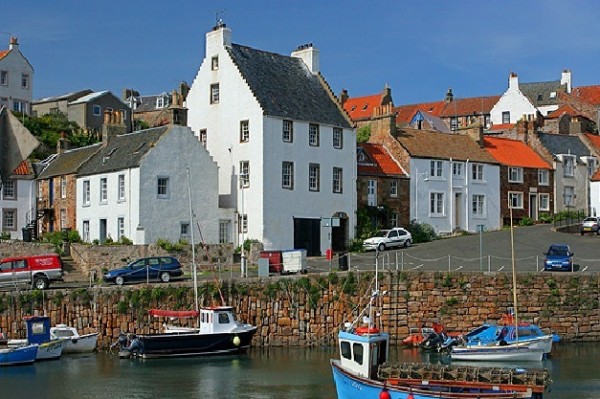
The Red Pantiles of Fife
The region or county that I live in is called Fife, more commonly know as The Kingdom of Fife. Long before there was a notion of a land called “Scotland”, this peninsula of land was said to be the lower Kingdom of the Picts (or Painted Peoples) known as Fib. These ancient boundaries and names persist very much into the present day with even our local radio station having the moniker of The Kingdom FM.
Anyway, this is us in red, an apt colour for the map as one of the main signifier that you are indeed in the Kingdom is our red tiled roof known as pantiles.
In the many picturesque fishing villages that dot our coastline you can see this regional architectural detail of cheery red-tiled roofs, as in this image of the harbour at Anstruther (home of the award-winning Best Fish & Chip Shop 2008/9). There is as much leisure craft as there are fishing vessels in these small towns as their close proximity to both St. Andrew’s and Edinburgh make them very popular tourist destinations.
So how did these tiles become so popular in a country so dominated by slate (historically thatch) roofs? As you can see from this map Fife is much more conveniently situated for trade with the northern European countries such as the Netherlands that it would be to say, the Mediterranean or the new world.
And for several centuries before the joining of the crowns of Scotland and England (see Guy Fawkes Night), Scotland, and the area of Fife in particular, had its own rich trading links with the Low Countries. Out would go our coal, wool, linen and salt, and on the return journey the ships hulls would be filled with the red pantiles as ballast. These intrepid traders were clearly influenced by their Flemish neighbours and as their ships were full of the stuff anyway, they decided to incorporate some of the nifty roof work back home (maybe traditional thatched roof were becoming passée).
This is a an amazingly preserved village close to me called Culross (pronounced coo-ros), founded by Saint Serf in the 6th century. (Saint Serf was to have given shelter to the unmarried but pregnant princess who later became Saint Enoch, and together they then married and raised her son who was to become Saint Kentigern or Saint Mungo. He, in turn went on to found Glasgow – beat that in your xmas card babe!) It is here that you can still see some of the original examples of this Flemish influence in the red pantiles and crow stepped gable ends on the buildings.
During the 16th and 17th centuries Culross was in its heyday boasting wealth from international trade in its coal (from the world first under-sea coal mine built in 1575) salt from panning and a monopoly in small iron girdles used for baking over an open fire. Its fortunes fell fast during the 18th century as the harbour was filled in, and by Victorian times it was totally cut off from access to the open sea by the construction of the coastal railway. By the late 19th century it was a ghost town and was only “rescued” from obliteration by the National Trust for Scotland who have been working on its preservation from the 1930s.
While not every building is roofed with pantiles, as in the town hall – which has also served as a courthouse and prison (the window beneath the clock face is rumoured to be where they kept the witches before trials – happy days),
many buildings, both municipal and residential do still sport their snazzy red roofs.
This regional feature is so associated with the area that even new buildings often incorporate it into modern construction. The drawing on the left is a sample from a Barrett home built down south in Manchester (with its presumably regional mock Tudor details) and the same home by the same builder as it exists in Fife.
Whilst these tiles are designed to live their lives on the rooftops, many have taken flight over the last few weeks in our extraordinarily intense storms. While many were weakened from our major snowstorms last year, it was the double whammy of our naughtily named Hurricane Bawbag of the 5th of December and our way more scary unnamed storm of the 3rd of January this year that have delivered us a serious hammering. With gusts of wind at 165 mph and 102 mph respectively, we sat huddled in our homes while the winds battered us and sent our beloved regional roof bits flying. (She’s breaking up Cap’t and she cannae take any more!)
So we have taken to gathering the bits of our rooftops from our neighbours yards and surveying the damage just about everywhere in sight. Additionally, we can while away the last of our winter holidays sifting through the dozens of form letters pushed through our mail slot from concerned roofing companies (who must surely be licking their chops about now) about how sorry they are to see the damage we have sustained and to please call them if they can be of any help.
http://www.historic-scotland.gov.uk/informguide-pantiles.pdf
But me? I am going old skool and resorting to my handy copy of Historic Scotland’s primer on maintaining a pantiled roof. If there is one thing about living in such an old country with so much history, you do learn to just deal with what comes and count the blessings of what you still have, or as they say here, “Och, wheest an get oan wae it”. Cause winds or no, the red roofs will remain one of Fife’s most distinctive features.
Stay warm & dry!














